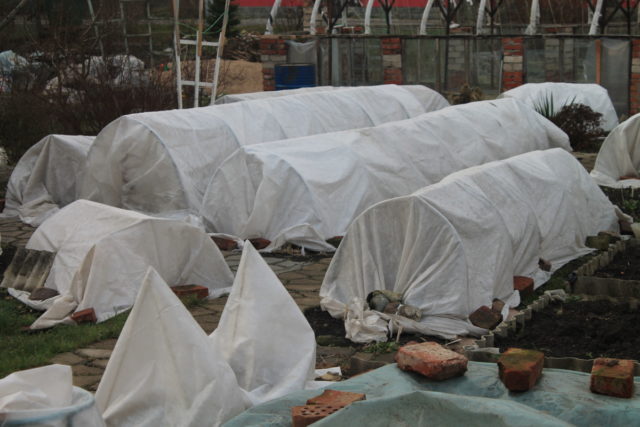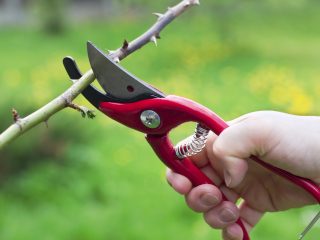Content
- 1 History of selection
- 2 Description of the climbing rose Indigoletta and characteristics
- 3 What is the difference between the climbing rose Ingoletta and Indigoletta?
- 4 Reproduction methods
- 5 Planting and caring for the climbing rose Indigoletta
- 6 Pests and diseases
- 7 Climbing rose Indigoletta in landscape design
- 8 Conclusion
- 9 Reviews with photos about the climbing rose Indigoletta
Climbing roses are valued for their wide range of uses in landscape design. They cannot be called undemanding in care, but for the sake of decorativeness, gardeners are ready to devote time and effort to the plant. The color of the petals varies widely - from “classic” to the most unusual shades. In this regard, the climbing rose Indigoletta with inky purple flowers stands out.
History of selection
Indigoletta is a climbing rose, bred in the Netherlands (Limburg) in 1981. The authorship belongs to the breeder van de Laak. The official name of the flower is Azubis, but it did not “take root”. It is also found under the names Morvana and under the nicknames Blue Lady or Blue Queen.
Climbers (or “climbing” roses) are the result of crossing climbing varieties with hybrid teas or floribundas. From the former they inherit long shoots, from the latter - large bright flowers.Such varieties cannot climb along a support, but they successfully “climb” along any vertical.
Description of the climbing rose Indigoletta and characteristics
The climbing rose Indigoletta is a vigorous, densely leafy bush with a diameter of about 1.5 m with powerful erect shoots reaching a height of 2.5-3 m. The leaves are leathery, deep green, glossy.
The buds are a very dark purple hue, slightly elongated. When they open, the petals lighten, becoming inky, lilac, purple, sometimes with a crimson, bluish, lavender tint. The flowers of the climbing rose Indigoletta are quite large - 8-10 cm in diameter, double (22-30 petals), with 2-3 buds on each stem. The shape is classic, typical of hybrid tea roses - the “glass” gradually turns into a “saucer”. The stamens are not visible even when they are fully expanded.
Flowering is very abundant and long lasting. The first “wave” occurs in mid-June to late July. Then the buds open en masse in the second half of August and early September. Individual flowers appear until the first frost. In the subtropical climate of southern Russia - until November-December.

Thanks to its unusual color, the Indigoletta rose will not get lost even in the largest collection of varieties.
One of the main features of the climbing rose Indigoletta is a very rich, almost “perfume” aroma. In intensity it is comparable to the smell of Damask roses. Experts detect notes of honey, lily of the valley and violet in it.
The climbing rose Indigoletta demonstrates good resistance to diseases, but only if you follow the recommendations for planting it and with proper care.In this case, it suffers from fungi only if their development is promoted by rainy weather and excessive watering.
In terms of frost resistance, the variety belongs to the sixth zone. It will overwinter without shelter at a temperature of -22-25 °C. But this only applies to absolutely healthy bushes, so it is still recommended to play it safe and provide the plants with protection from the cold. Indigoletta is not suitable for the Urals and Siberia, but for the European part of Russia it is quite suitable.
This climbing rose suffers little from rain. Even heavy rainfall will only damage individual flowers. Unopened buds also do not fall off.
The undoubted advantages of the Indigoletta rose include:
- rare colors of petals;
- wide possibilities of use in landscape design;
- abundance and duration of flowering;
- resistance of flowers to precipitation;
- good immunity in optimal conditions and with quality care.
There are also disadvantages:
- insufficient cold resistance for many Russian regions;
- difficulties in preparing for winter (hard shoots are difficult to bend to the ground without breaking them);
- the need for regular pruning;
- petals fading to a faded purple or even ashy shade in direct sunlight (but light is vital for her);
- sensitivity to high humidity of the substrate and air (diseases develop).
What is the difference between the climbing rose Ingoletta and Indigoletta?
There is no rose called "Ingoletta". Some gardeners abbreviate its name this way, but this is incorrect.If such a “variety” is found on sale, you should definitely refrain from buying it.
Reproduction methods
For propagation of the lilac climbing rose Indigoletta, cuttings are best suited. Digging up and dividing an adult bush is problematic because of its size, and such an operation does not always guarantee success. It is not possible to obtain layering, because it is very difficult to bend the shoots to the ground without breaking them.
Rose cuttings are cut when the first “wave” of flowering ends. You need to take the middle part of an annual shoot about 15 cm long with 3-4 growth buds. The lower cut is made obliquely, the upper cut is made straight. Leaves are cut in half.
Root the cuttings in a “greenhouse”, in a mixture of peat with sand, perlite (1:1), planting them at a slight angle. To speed up the process, it is recommended to sprinkle the lower cut or soak it in a root formation stimulator.

It is best to cut rose cuttings early in the morning.
Planting and caring for the climbing rose Indigoletta
The climbing rose of the Indigoletta variety manifests itself best only if you choose the right place for planting. The main requirement is good lighting. But during hours of maximum solar activity, it needs light partial shade.
The plant is large, so when planting several specimens, leave at least 1-1.2 m between them. At least a meter is set back from any continuous vertical support, providing ventilation. But Indigoletta can grow without “support”; powerful shoots do not bend either on their own or under gusts of wind or rain.

The climbing rose Indigoletta is demanding on lighting; in the shade it greatly loses its decorative properties
For the first time, the climbing rose Indigoletta is watered abundantly immediately after planting, using up to 20 liters of water. Then, during this season, the soil is moistened every 2-3 days, preventing it from drying out. In subsequent years, the intervals are increased to 5-10 days, taking into account precipitation. The next watering is carried out when the soil in the tree trunk circle dries out to 5-7 cm in depth. It is not necessary to pour water only at the root - the bush and flowers do not suffer from sprinkling.
After each watering, the soil in the flowerbed is carefully loosened. It is highly recommended to cover it with mulch and replenish this layer as necessary. Mulching allows you to increase the intervals between waterings and save time on weeding.
The large size and abundance of flowering of the climbing rose Indigoletta determine the plant's increased need for nutrients. At the beginning of the growing season, humus or compost must be added to the tree trunk circle to maintain soil fertility and mineral nitrogen-containing fertilizers necessary for growing green mass.
Then, at intervals of 3-4 weeks, Indigoletta is fed with special products for roses. At the end of the second “wave” of flowering, phosphorus and potassium are added.

Store-bought fertilizers are a balanced “set” of macro- and microelements in the right proportions
When feeding a rose with folk remedies, it is very difficult to provide it with these nutrients.
Pruning is carried out twice per season. In the spring, before sap flow has yet begun, they get rid of frozen and broken shoots.In the fall, stems that have not yet become lignified are cut out, others are shortened by a maximum of 30 cm. Of the second-order shoots, from a third to a half are left, choosing the most powerful and “productive”.
Indigoletta is covered if the temperature is predicted to be -20 °C or lower in winter. A “trench” of sufficient length, 15-20 cm deep, is dug next to the bush. Its bottom is covered with fallen leaves, hay, and spruce branches. The shoots are removed from the support or simply bent and placed on a “pillow”. Arcs are installed on top and a breathable covering material is pulled over them.

The shelter for the climbing rose Indigoletta must allow air to pass through
If you cannot bend the shoots of a climbing rose, they are wrapped with the same covering material in a vertical position in 2-2 layers. The base of the bush is hilled high.
https://youtu.be/75TaVNRT464
Pests and diseases
Pests are extremely rarely interested in the climbing purple rose Indigoletta. To avoid their attacks, it is enough to treat the bush and the soil under it with any universal broad-spectrum insecticide once a month during the active growing season.
The plant's immunity is generally good. But Indigoletta is very sensitive to high humidity. Under such conditions, it quickly becomes infected with powdery mildew (a whitish powdery coating on all parts of the plant, gradually turning into black-brown “mucus”) and black spotting (brown-black spots, around which the yellowness spreads, soon becoming “lumpy”).

Black spot is one of the most dangerous diseases for roses.
The best prevention is proper watering of the plant. If rainy weather sets in, the climbing rose Indigoletta and the soil in the trunk circle are sprayed with a solution of any fungicide every 7-10 days.
Climbing rose Indigoletta in landscape design
The description of the climbing rose Indigoletta, as well as photos and reviews from gardeners, suggest that in landscape design it is used mainly for decorating any vertical surfaces - walls of buildings, gazebos, fences, pergolas, trellises. The height of the bushes allows you to form them into a hedge. An interesting solution is zoning the territory of the site with its help.
Indigoletta's shoots are erect, so it can also be planted as a tapeworm. On a bright green, well-groomed lawn, flowers of an unusual purple hue immediately attract the eye. Groups of one climber and three low-growing rose bushes look no less impressive. The best color to combine with lilac is snow-white, also soft pink, pastel yellow, cream, and peach.

Rosa Indigoletta will not get lost even “solo”, but you can create “company” for her
Conclusion
Climbing rose Indigoletta is a decorative and original variety. Thanks to the unusual lilac-lilac color of the petals, it will not get lost even in the largest rose garden. The pronounced aroma also attracts attention. Caring for a flower cannot be called simple, but nothing extraordinary is required from the gardener. You just need to study the important nuances of agricultural technology in advance.











